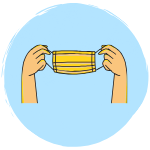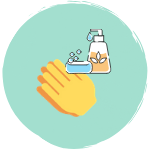
How to reduce your risk as we slowly open back up
As much as we all want to go back to the way things used to be, the reality is that this is the new normal for the next 1 to 2 years, or beyond.
From the public health standpoint, it is safest to reopen when there are widespread testing, as well as extensive contact tracing. Most of the United States are no where near having enough personel to do the extensive contracting traacing required, though efforts are under way to double that number. And test availability has been a big disappointment, with test criteria imposed by state health departments so strict and outdated that most people cannot qualify and get tested.
That aside, the battle against COVID-19 is fought and won in the community, and the real heroes are those who practice social distancing, wear masks, and wash their hands frequently to stop the chain of transmission of this virus.

The SARS-CoV-2 virus, also known as the new coronavirus, is spread mainly via droplets and microdroplets, and possibly also via aerosols.
The droplets and microdroplets are created and propelled when someone is sneezing, coughing, or even talking.
44% of cases are transmitted in the pre-symptomatic stages, in addition to spreading by individuals who are completely asymptomatic, even 2 weeks into the illness.
Homemade masks with space for a filter is a great option. If at least 80% of us wear a mask, the outbreak will be dramatically mitigated.

The viral droplets and microdroplets can travel up to 6 feet, while aerosolized particles can travel even further.
An infected individual can be completely asymptomatic for an average of 5 days (and up to 14 days) before showing any symptoms, and even so, can be very mild in about 80% of individuals that they can be easily disregarded.
To keep R0 at less than 1 and stop the spread of this virus, social distancing should be the new normal, and continued to be practiced everywhere by everyone. This will help protect our neighbors over the age of 65, who as a whole accounts for more than half of the ICU admissions, and 80% of the deaths associated with COVID-19.

Frequent hand washing is key to reduce the germs on your hands, especially …
- Before:
- Eating, drinking or handling food
- Touching your face or items on your face (masks, glasses, etc.)
- After touching:
- Outside the home: elevator buttons, door handles, grocery carts, etc.
- At work: common keyboards and mice, telephones, door handles, etc.
Wash with soap and water thoroughly for at least 20 seconds, or with properly made alcohol-based hand sanitizers for at least 30 seconds. If your hands are dry 10-15 seconds after rubbing them in, you are not using enough hand sanitizers.
How to go about daily life?
Avoid crowded indoor spaces with limited ventilation
#COVID19 #SARS-CoV-2 #dpc #directprimarycare #lockdown






